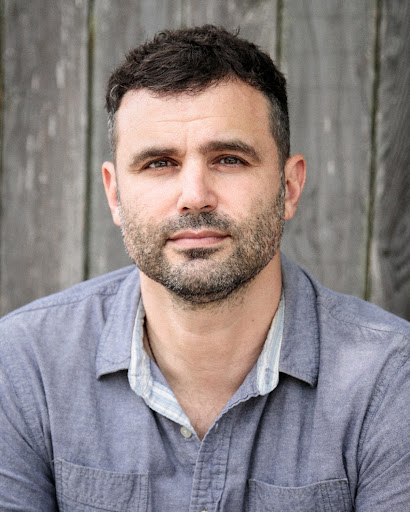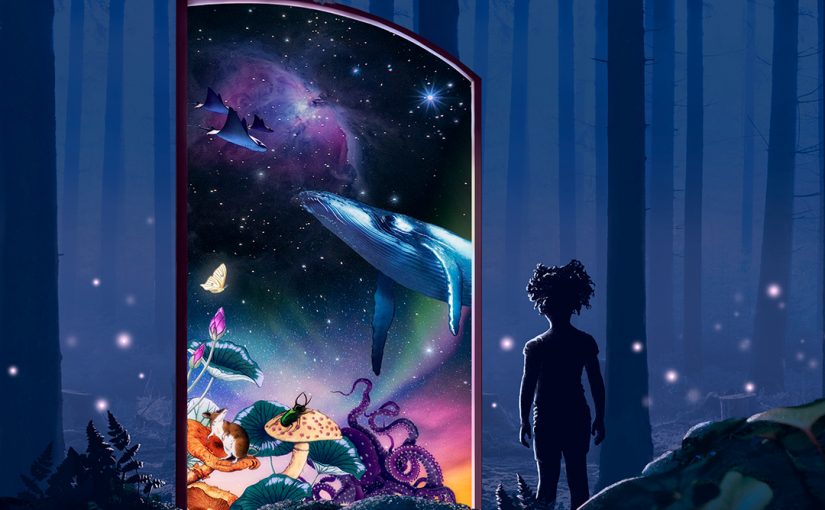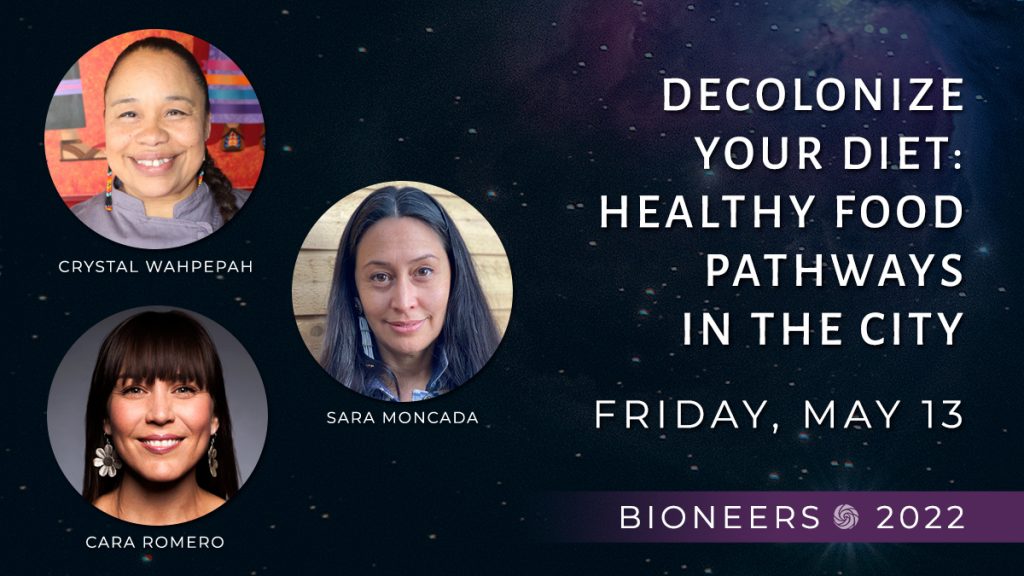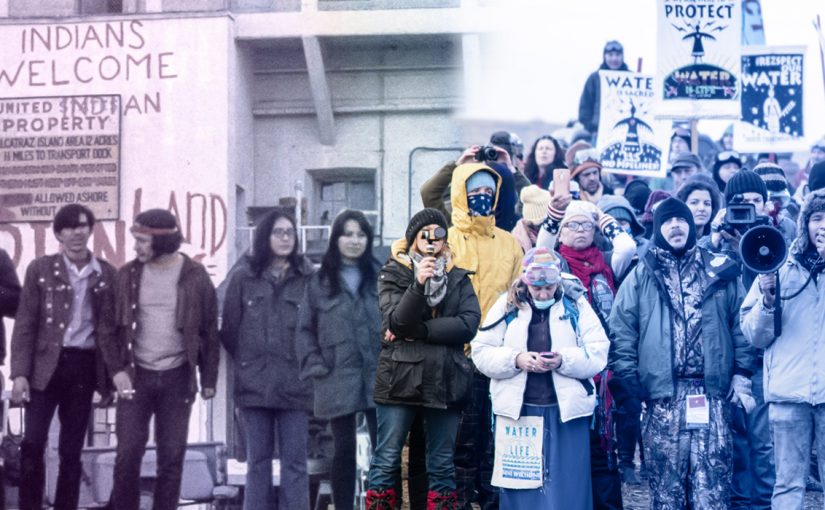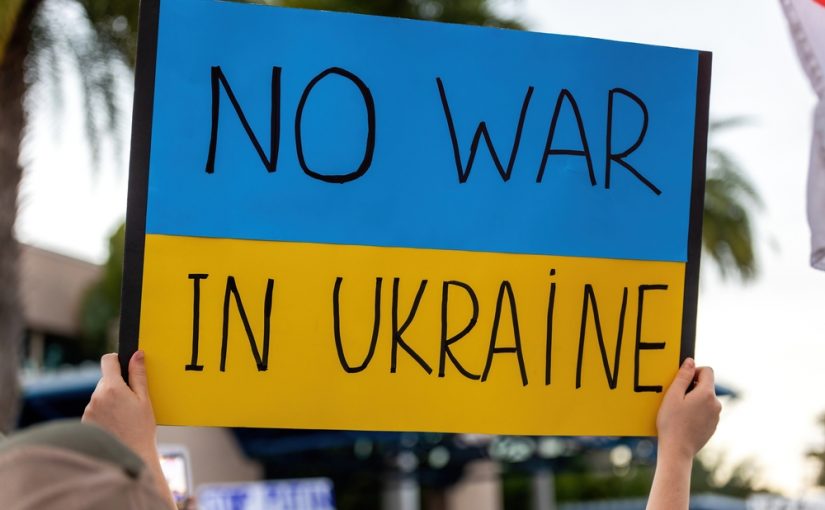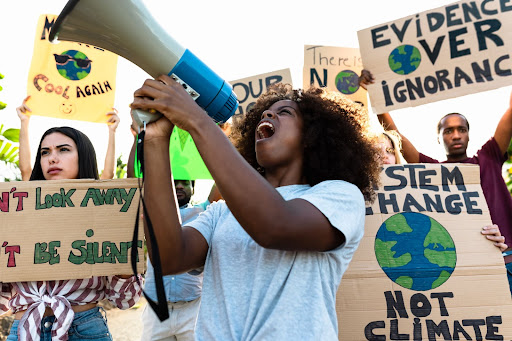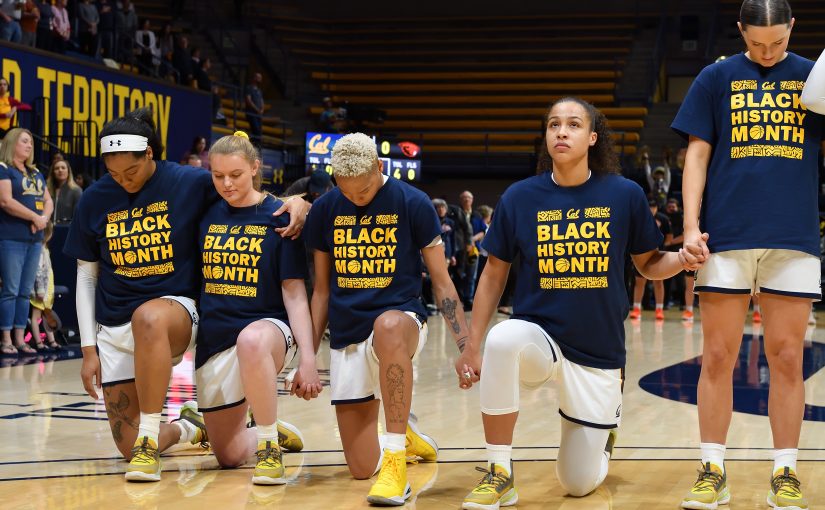California Indians have survived some of the most extreme acts of genocide committed against Native Americans. Prior to the ongoing genocide under Spanish and American colonizations, California Indians were the most linguistically diverse and population dense First Peoples in the United States. We discuss this brutal history and survivance with Corrina Gould, Co-Founder and Co-Director of the Sogorea Te’ Land Trust. She is from the Lisjan/Ohlone tribe of Northern California. We talk about the importance of addressing that historical trauma, which caused deep wounds that still affect Indigenous Peoples today.
Content warning: Some of the material in this podcast may be triggering, especially for those that have experienced trauma and/or intergenerational trauma due to colonialism.
Corrina Gould (Lisjan/Ohlone) is the chair and spokesperson for the Confederated Villages of Lisjan, as well as the Co-Director for The Sogorea Te’ Land Trust, a women-led organization within the urban setting of her ancestral territory of the Bay Area that works to return Indigenous land to Indigenous people. Born and raised in her ancestral homeland, the territory of Huchiun, she is the mother of three and grandmother of four. Corrina has worked on preserving and protecting the sacred burial sites of her ancestors throughout the Bay Area for decades.

Resources
California Indian Genocide and Resilience | 2017 Bioneers panel in which four California Indian leaders share the stories of kidnappings, mass murders, and slavery that took place under Spanish, Mexican and American colonizations — and how today’s generation is dealing with the contemporary implications.
This is an episode of Indigeneity Conversations, a podcast series that features deep and engaging conversations with Native culture bearers, scholars, movement leaders, and non-Native allies on the most important issues and solutions in Indian Country. Bringing Indigenous voices to global conversations. Visit the Indigeneity Conversations homepage to learn more.
Credits
Executive Producer: Kenny Ausubel
Co-Hosts and Producers: Cara Romero and Alexis Bunten
Senior Producer: Stephanie Welch
Associate Producer and Program Engineer: Emily Harris
Consulting Producer: Teo Grossman
Studio Engineers: Brandon Pinard and Theo Badashi
Tech Support: Tyson Russell
This episode’s artwork features photography by Cara Romero, Co-Director of the Bioneers Indigeneity Program as well as an award winning contemporary fine art photographer. Mer Young creates the series collage artwork.
Additional music provided by Nagamo.ca, connecting producers and content creators with Indigenous composers.
Transcript
CARA ROMERO: Hi, Everyone. Welcome to Indigeneity Conversations. I’m Cara Romero, co-host and also Co-Director of the Bioneers Indigeneity Program along with Alexis Bunten.
ALEXIS BUNTEN: Hi Everyone. Today is part one of a wonderful conversation with Corrina Gould. She is from the Lisjan/Ohlone tribe of Northern California. Born and raised in her ancestral homeland, Corrina is the mother of three, grandmother of four and a celebrated leader and activist of the First Peoples of the Bay Area.
Corrina co-founded the grassroots organization “Indian People Organizing for Change” which works to defend and preserve sacred Ohlone shell mounds formed over generations.
She is the Co-Founder and Co-Director of the Sogorea Te’ Land Trust, a Native American land conservancy in the heart of an urban epi-center.
CARA ROMERO: I talked with Corrina about the brutal history of colonization of what is now called California. So much of that history is erased in schools and students aren’t given a real understanding of that legacy. It’s important that we as people indigenous to this land share how that legacy still affects our families and the deep wounds that we are all still experiencing from colonization.
I started the conversation by asking Corrina to talk about the lay of the land in the Bay Area, and to tell us about her tribe and affiliated tribes who call the East Bay and the surrounding area home.
CORRINA GOULD: What happened when colonization occurred in the Bay Area that we were all given the designation of Costanoan. And Costanoan is what the Spaniards called us, thinking we were all kind of the same people with—oh, they all kind of dress alike; they all kind of, you know, eat the same stuff and live the same kind of ways, and so they’re all Costanoan. But actually what people now known as Ohlone, and which is a really generic term as well, is that there was actually multiple tribes within our language base areas.
And so where I’m at is in the East Bay, and our language is Chochenyo. My great-grandfather, José Guzmán, was one of the last speakers of the language. And he introduced himself, when he introduced himself, he says, I am Lisjan. And so our tribe is the confederated villages of Lisjan. We are taking back our traditional names of our areas.

In the East Bay, like in many places in California, there were multiple tribes, and the way I like to explain it today is if you can imagine a county, and within the county there are cities, and all of those cities are their own individual municipalities. They all speak the same language, but they all have control of different areas. The same was with the tribes a long time ago.
So along with the confederated villages of Lisjan in the East Bay, there is the Him’ren and the Muwekma. And so we all have ties to a specific part of our territory that we take care of in the East Bay, and we all have in common the language of Chochenyo.
CR: Thank you for explaining that. And it’s also beautiful to hear the proper pronunciations from an Ohlone person. Can you talk a little bit about life before colonization? Can you kind of lay out an illustration for the audience, because now it’s so metropolitan; it’s so developed. Can you describe the stories that have come through to you about what life was like prior to contact?
CG: Yeah. You know I always dream about what it must have been like in my home territory that’s been totally urbanized. And, you know, we have thousands of people now that come and live in our territory and have no concept of the sacredness of the lands that are here. And, if we just take Oakland, for example, we had over in our territory, in this area, we probably had about 30 different creeks in Oakland that ran all the time, and it was freshwater and still had trout, rainbow trout. Salmon would run up it. So just 200 years ago this abundance was here in the Bay Area. There was no such thing as hunger or homelessness in the Bay Area 200 years ago, and that—to imagine that today, thousands of people living on the streets that are hungry and cold and without enough.
You know, I really believe that my ancestors lay down prayers in the Bay Area around this abundance and for us to really be able to see a vision in a different way. The Bay Area has this magical way of growing technology and ideas and movements, and I really believe that it’s the—that our ancestors put that down.

If we imagine Oakland, its name, was named after a grove, you know, a forest of oak trees that were here. Our ancestors, of course, ate acorns, but we ate tons of stuff. So the Bay Area was full of plains of wild flowers and seeds that we ate as well, tule elk and deer, and rabbit, and quail, all kinds of animals, birds, thousands and thousands of species of birds. I like that Malcolm Margolin beautifully poetically puts in Ohlone Way how at one time that there were so many birds in the Bay Area that when they would lift up off the ground, it would practically blacken out the sky. You know? Grizzly bear lived here and we never talk about our relative, the grizzly, that we lived in reciprocity with. We learned to live with this huge relative and allowed them their space to do what they needed to do. You know? We ate shellfish and we had tons of food that we could eat in the Bay, and nothing was poisoned.
And so, you know, just to think about the beauty and the magnitude that our ancestors lived on with everything that was here that they needed; that there was no worry for anything; that our songs are even filled with gratefulness for the abundance that we had on this land. And I think that that abundance still is here, but we as human beings need to figure out a way to come back to living in reciprocity with the land so that she takes care of all of us in the way that she has for thousands of years.
CR: That’s one of the things that we really try to emphasize through our work is the importance of indigenous leadership when it comes to all peoples, including settler colonials, learning to reindigenize their ways of living, even if they’re in these urban epicenters, because without those ideas of reciprocity that you’re talking about, we’re never going to be in balance, even in our urban areas.
So Corrina, can you talk a little bit about the waves of colonization as you understand them, specifically the Spanish, the Mexican, and the American waves of colonization and how that touched your family and your ancestors?
CG: Yeah. You know, I often talk about in 1776, when they were fighting for their independence on the other side of the country. Here in California we were just beginning to be devastated by the Spanish colonization and mission system that—you know, it was around that time. So our colonization happened differently and in three different waves, consecutively, of these genocide by different people.
And so, you know, the Spaniards got here and they set up the—by holding down land. That’s what they wanted to do. And I think it was 1546, Cabrillo was coming down the coast of California and he saw the land. What I was told was that he saw the land because there was smoke on the land, and it was because our people had set intentional fires in order to clear the underbrush of the oak forests so that—living in reciprocity with the land, that, you know, by clearing it out using fire as a tool would allow for the underbrush to be gone so it wouldn’t cause huge wildfires, that basket materials would come up straight so we would have those materials. It would also bring—those new shoots would bring in deer and Tully elk, so there would be game for us to have. So there was this way of living together in that kind of way. And while he was coming down the coast of California, saw these smoke fires and saw the land, and called dibs on the land.
And really I think that most people understand what calling dibs is. Right? It’s like if I got, you know, a pink box that has one donut in it and you call dibs, that’s your donut. And so without getting off of the ship, coming down the coast at that time, he called dibs on—for Spain and the crown, on our land, without talking to us, without having conversations. And ended up going all the way down to San Diego. And he died about four days later, but not before claiming that land for Spain and the crown. You know, using the Doctrine of Discovery, which I think people think is a thing that’s a really old law that doesn’t actually work today but actually used it against Native people about 10 to 12 years ago in New York when they were getting land returned to them and some—a body of water, and used the Doctrine of Discovery against Native people. And so this isn’t an old law that was used just a long time ago to take land, but it continues to be used today.
They stayed away for about 200 years, and Spain decided that they were afraid they were going to lose the land they called dibs on, and because Russia was doing fur trade with Northern California people, and in order to hold down their land decided that they were going to use the Spanish missions to hold the land down. They had done this already in Mexico with the Indigenous Peoples there, and there was this man from Spain who was a fanatic. His name was Junípero Serra, and enslaved Native people from the bottom of California all the way up to my territory.
And our ancestors built these missions. You know? I know that they brought some people with them, but there was not enough labor to do the work of creating these missions, you know, these missions that are mythologized around how there was this beauty that was brought here, but what those missions brought to us was disease and starvation, an idea of whipping somebody and this cruelty of outright murder and imprisonment, things our people had never seen before, had not conceptualized the cruelty that happened there. You know? And you became the property of the missions once you were baptized, and you couldn’t go home. And pretty soon, home wasn’t even home anymore…
And our ancestors became slaves in these missions, and really died not only of starvation and disease but heartbreak. Imagine living on a land for thousands of years in reciprocity and then having to fall in line with the ideology that you could never even conceive of. There’s no freedom. There’s no abundance anymore. There’s no laughter.
And so for about 99 years, the Spanish missions were here. And then settlerization happened, and Spain lost their control over the lands. And Mexico took the lands that Spain had once held with the missions. And so we think that the Native people would go free and that our ancestors would go back to living the way that they had for thousands of years, but that’s not true because land grants were given to Spanish gentry and officers in the military. And so these huge swathes of land where I am right now, it was San Antonio, and it was the Peralta family that held that land from San Leandro all the way to Albany, a lot of our territories with multiple creeks there
And so our ancestors went quite literally from being slaves at these missions to being slaves on these ranchos – Vallejo and Bernal, and multiple people that—you can see their names that are etched still in the names of streets and places inside of California. These are the gentry that received this land and received our people as slaves.
CR: The truth is that California has one of the most brutal colonial histories of the United States. But instead in fourth grade, we do learn about the mission system. We learned that the Indians wandered to the missions looking for food and shelter. We learn about the Gold Rush and the land of milk and honey, and how the colonial peoples came to — in the academic setting — to an empty landscape, just ready to be settled, and nothing could be further from the truth.
Then there was the Mexican-American War, and during that period, you know, there was a lot of things that happened, but one of the things that happened was that after the war was completed, there was a treaty that was signed. It was the Treaty of Guadalupe de Hidalgo. And in that treaty it said that Native people were supposed to get some of their land back. But in fact, true to its nature, the United States government broke that treaty, as it has broken every other treaty that was signed with Native people, and the first laws in California were laws of extermination. They were not about creating treaties with Native people anymore, it was about extermination laws.

And this is the history that we’re not told when we’re fourth grade learning about history. You know, we hear about the Gold Rush and people rushing into our territories looking for this gold. And what I like to remind people is that Native people knew about gold and left gold alone. It wasn’t something that we were fighting over or dying over, but people, with this greed in their mind, came here.
And we don’t talk about the slavery that happened in California, because California was created as a free state, and so people that had African slaves, with this dream of bringing them here to work mines, wasn’t true. That once they got here with African slaves those slaves were free, but they could enslave Native people, and they could hunt us down legally, and backed by the federal dollars of $1.7 million, they killed off Native people as fast as they could. Not everybody could find gold, but they could find Native people to hunt down – adults, $5 a head, and 25 cents an ear. And they can gather the children up and they can sell them into servitude. About $300 for a little girl, $180 to $200 for a little boy.
And then the destruction and the devastation of our family cultures begin to be pulled apart. There were vagrancy laws, which I’m really afraid of right now because we have so many people that are living on the streets, and how I equate them with our own ancestors that were not living in the same way as this Western ideology. These vagrancy laws allowed white men to pull Native people off the streets and into a court of law where they had no voice. And would take them before a justice of the peace and say that they were vagrant, and the court would allow that rancher, that miner, to take those Native people into their custody as long as they could feed them and clothe them for the next 25 to 30 years. So that was slavery in California that we never talk about.
CR: We never talk about it. And thank you so much for taking us through that history. I think the other thing that people don’t realize is what you were just touching on, about this idea of selling scalps for money, and the idea of selling young girls into indentured servitude was not that long ago. This is something that for me, my great-grandmother lived through, and my grandmother also felt the ramifications of those laws. This was going on up until 1907, the payment for Indian scalps. And my grandmother was born in 1925, and still at that time, in Southern California, actually right on the border of Nevada, when non-Native Peoples would come around, she was to hide in the basement. She was to hide in the cellar and not come out so that nobody could bear witness to a young Native girl there, because the fear was that they could take her and sell her into indentured servitude. This was all the way up until 1930.
I have heard stories from the elders in my tribe in Southern California, not just about those atrocities specifically with young women, but also about the racism.
I think people don’t realize that many of our grandmothers in California were not born US citizens. We did not gain US citizenship until 1924 in California. I think that that shocks people to realize that there was a caste system in California for people of color, and Native American Californians were at the very bottom of the caste system, beneath Mexicans. And often the stories of my grandmother’s generation is that many of them, while simultaneously being sent off to boarding school and residential schools, were also being told not to speak Indian, or not to speak their Native languages, that it was okay to speak Spanish.
And that many of the stories come down to people seeking work, exiled in these urban centers, trying to pass for Mexican. Taking on Spanish last names was very common, and that was in order to pass as Mexican, meant that you were able to get a job. You were able to be a caretaker for kids, perhaps. You were able to be a servant in the home.
But here again, just kind of examining that, for people to understand what they are not taught in academic settings in California. I know that there’s a big movement to begin teaching those things in the academic setting. And so thank you for being here to expand on those.
Can you tell me a few of the stories of your grandmother’s? The things that she endured and the things that come down through oral tradition to you?
CG: Yeah. You know, we share that history of having to take on the Spanish surnames and pretend—it was safer to pretend to be Mexican and to work on ranches. You know, our people that left Mission San Jose, because we were enslaved both at Mission Dolores in San Francisco and Mission San Jose in Fremont, and, you know, we tried to create an Indian township, and we ended up being called—the name that they put us down in the Bureau of Indian Affairs — was the Verona band of Mission Indians, and that was because we lived along the railroad station, the Verona station that the Hearst family had put in so that their friends could come and visit them at the Hearst family place. And so we were really kind of like owned by the Hearst family. When you really think about it, it was like that’s who we worked for, that’s who our families worked for.
My mom was born in 1940. Her sister was born in 1936, and she’s still alive. She’s the matriarch of our family. And they were torn apart as a family very young. My mom was taken away from my grandmother at birth, at the hospital, and was given to a Portuguese family to raise until she was about 8 years old. And then she was sent to boarding school. My auntie and my uncle were sent to boarding school. So they all went to Chemawa boarding school and were reunited there after many years of being separated.
And after a while, my auntie was taken to San Leandro. And she just told us this story a few years ago. We were all sitting in her living room a few years ago, and she talked about leaving Chemawa when she was about 12, and how they taught her to read and write, but really what they were teaching her was how to be industrious and to get a job, and that she would be placed in a home when she was about 12 years old in San Leandro, which is not too far. It’s like a couple of blocks from where I live right now. And, you know, she was talking and telling this story, and she’s like, “You know,“ She goes, “I got placed in this white family’s home. And they were so nice. I washed their clothes, I watched their kids, I cooked for them, and scrubbed their floors.” And she’s just telling this nonchalantly all of a sudden. She goes, “They wanted to send me to school. They were so nice, they wanted to send me to school.” And the city of San Leandro would not allow her to go to school because she was too dark.
And so really, we’re talking about 1948, 1950, around that time. So it’s not like something that was a long time ago. My auntie, she’s gone through a lot of different things. She’s the matriarch of our family, and has had to bear brunts of colonization and historical trauma that happened. She’s lost many of her children because of what happens to our people when there is so much trauma in our lives.
Yeah, colonization continues to destroy the fabric of our families because the healing has to happen. And I think that’s what’s happening now. We’re in this place where during the—And it’s in my lifetime that we’ve been able to stand up and talk about what historical trauma is and how it’s affected our families and how do we find our way back to where our ancestors always wanted us to be.

CR: They give me strength, all of those stories. I’m so thankful for our oral histories that have been passed down. And those generations went through so much, that continue to give us strength to tell the stories, to rewrite our histories so that they’re told accurately. These things were going on, you know, not that long after losing land base and being shuffled around, and disease sweeping through.
My great-grandmother died of tuberculosis when my grandmother was 12 years old. And her and her brother became wards of the state and were raised at Sherman Indian School in Riverside, California, a very common story, and their resilience and their survival comes through in the same way like what you’re talking about, a very nonchalant telling of survival, of what boarding school was like and how they weren’t allowed to study academics only vocational trade.
And so I would ask my grandmother, “What did you go to school for?” And she said, “Well, I went for—” basically commercial cooking and cosmetology were two majors that she had in school. And then moved out to the Los Angeles area. By this time, our tribe had—our reservation had been withdrawn in 1907, but we did not have federal recognition for our tribe.
And just to kind of give people an idea of one history, of one tribe in Southern California, our ancestral territory was so much of the Mojave Desert. Right? It goes from Las Vegas, Nevada out to Victorville and Kern County, which is, you know, really close to the Los Angeles area, and then all the way down to Parker, Arizona. And then this reservation is withdrawn where 10 families from our entire tribe lived. That was where they said, “Okay, well you can’t have all of this ancestral territory, so we’re going to compact it into this area along the Colorado River.” And that doesn’t really jive with the way people were living. We have still in our tribe, like northerners and westerners and southerners, and each family, you know, now living on the reservation or, coming back to the reservation for political or ceremonial gatherings have those stories about where their families are originally from. We still talk about that 100 years later, about where your families are truly from.
But we didn’t gain our federal recognition until the 1960s, 1970 to be exact. So our grandmothers and our aunties were living without land base. They were surviving in boarding schools, in urban centers, and they were still activists. They were existing against all odds. And those stories give me so much strength.
CR: So that’s the first part of our conversation with Corrina Gould. In part two, we talk to Corrina about the critical differences between federally recognized and non-federally recognized tribes. There are historical and contemporary inequities that those differences present when it comes to defending land rights, preserving culture, and having a sovereign nation-to-nation status with the federal government.
AB: Yes, and you can hear and see more from Corrina Gould by going to our website bioneers.org. We have other episodes there to listen to and share, and we offer even more original Indigenous media content. You’ll also learn about the Indigeneity program and all of our initiatives, including curricula and learning materials for students and life-long learners alike.
CR: Thank you for joining us for this episode of Indigeneity Conversations. It’s been a pleasure to share with all of you today. Many thanks and take care!




